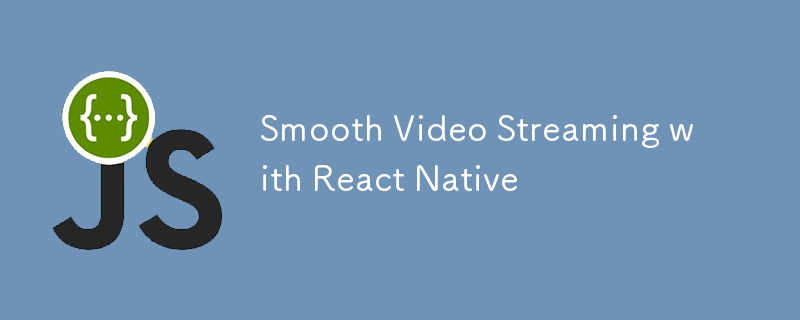

In today’s mobile-centric world, video streaming is a core feature of many applications. Whether it's a video-sharing platform, an educational app, or a multimedia-rich social network, providing a seamless video experience is essential. With React Native, a popular framework for building cross-platform mobile apps, integrating video streaming is made easy with the react-native-video library.
In this blog, we'll walk through the steps to install, configure, and use react-native-video to create a smooth video streaming experience in your React Native applications.
To get started, you need to install the react-native-video library in your React Native project.
Step 1: Install the package
First, install the library using npm or yarn:
npm install react-native-video react-native-video-cache
or
yarn add react-native-video react-native-video-cache
For iOS, you might need to install the necessary pods:
cd ios pod install cd ..
Step 2: Additional native setup for iOS/Android
i) android/build.gradle
buildscript { ext { // Enable IMA (Interactive Media Ads) integration with ExoPlayer useExoplayerIMA = true // Enable support for RTSP (Real-Time Streaming Protocol) with ExoPlayer useExoplayerRtsp = true // Enable support for Smooth Streaming with ExoPlayer useExoplayerSmoothStreaming = true // Enable support for DASH (Dynamic Adaptive Streaming over HTTP) with ExoPlayer useExoplayerDash = true // Enable support for HLS (HTTP Live Streaming) with ExoPlayer useExoplayerHls = true } } allprojects { repositories { mavenLocal() google() jcenter() maven { url "$rootDir/../node_modules/react-native-video-cache/android/libs" } } }
This configuration enables various streaming protocols (IMA, RTSP, Smooth Streaming, DASH, HLS) in ExoPlayer and sets up repositories to include local, Google, JCenter, and a custom Maven repository for react-native-video-cache.
Each of these features enabled will increase the size of your APK, so only enable the features you need. By default enabled features are: useExoplayerSmoothStreaming, useExoplayerDash, useExoplayerHls
ii) AndroidManifest.xml
The combination ensures that the app has enough memory to handle large datasets (via largeHeap) and can render graphics efficiently (via hardwareAccelerated), leading to a smoother and more stable user experience. However, both should be used with consideration of the app's performance and the specific needs of its functionality.
b) iOS:
i) In ios/your_app/AppDelegate.mm inside didFinishLaunchingWithOptions add:
#import- (BOOL)application:(UIApplication *)application didFinishLaunchingWithOptions:(NSDictionary *)launchOptions { self.moduleName = @"your_app"; // --- You can add your custom initial props in the dictionary below. [[AVAudioSession sharedInstance] setCategory:AVAudioSessionCategoryPlayback error:nil]; // --- They will be passed down to the ViewController used by React Native. self.initialProps = @{}; return [super application:application didFinishLaunchingWithOptions:launchOptions]; }
Ensuring that audio continues to play even when the app is in the background or in silent mode
ii) ios/Podfile:
... # ENABLE THIS FOR CACHEING THE VIDEOS platform :ios, min_ios_version_supported prepare_react_native_project! # -- ENABLE THIS FOR CACHEING THE VIDEOS $RNVideoUseVideoCaching=true ... target 'your_app' do config = use_native_modules! # ENABLE THIS FOR CACHEING THE VIDEOS pod 'SPTPersistentCache', :modular_headers => true; pod 'DVAssetLoaderDelegate', :modular_headers => true; ...
This configuration enables video caching in the iOS project by adding specific CocoaPods (SPTPersistentCache and DVAssetLoaderDelegate) that handle caching and asset loading. The flag $RNVideoUseVideoCaching=true signals that the project should use these caching capabilities. This setup improves the performance of video playback by reducing the need to re-fetch video files.
import Video from 'react-native-video'; import convertToProxyURL from 'react-native-video-cache';
To ensure smooth video playback:
The react-native-video library is a powerful tool for adding video functionality to your React Native applications. With its extensive configuration options and event handling capabilities, you can create a smooth and customized video streaming experience for your users. Whether you need a basic player or a fully customized one, react-native-video has you covered.
The above is the detailed content of Smooth Video Streaming with React Native. For more information, please follow other related articles on the PHP Chinese website!




